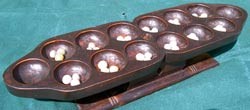Resource 3: The cultural game of Africa
![]() Pupil use
Pupil use
This game has many names, for example:
- Oware by Asante in Ghana
- Kpo by Vai people of Sierra Leone and Liberia
- Ajua by Luo in Kenya
- Omweso by Ganda of Uganda
- Bao by Swahili in East Africa
- Gambatta in Ethiopia
- Ayo by Yoruba in Nigeria

In the past, boards for playing the game have been made from beautifully carved wood, bronze (in the royal court of Benin, Nigeria) or gold (by the Asante Kings in Ghana). Now there are less elaborate versions available and you can make your own using a piece of cardboard and drawing the required number of circles.
RULES FOR PLAYING OWARE
The object of the game is to capture more pieces than your opponent.
The board consists of two rows of six cells, holes or cups. Each player owns a row. There are two extra cells, not part of the board proper, for holding each player's captives.
The pieces are all alike. They are sometimes referred to as stones, pebbles or seeds. There are 48 in all.
At the start of the game the 48 pieces are distributed evenly in the 12 cells – four to a cell.
To make a move a player picks up all the pieces in a cell in his/her own row and moving counter-clockwise around the board, from his/her own row to the opponent's and back again to his/her own, deposits them, one at a time, in each cell that he/she passes over, without skipping, until the pieces are used up. If the number of pieces is large enough, the move may come back to the square which originated the move. In that case that square is bypassed, no piece being placed in it, and the seeding continues in the next cell.
The players take alternate turns to play and must make a move on each turn.
A capture occurs when the last piece of a move is deposited in a cell on the opponent's side and the number of pieces, after the drop, is either two or three. If the cell before the last was also raised to two or three then those pieces are also captured, and so on for each previous cup as long as the row is still the opponent's and no cell with a count other than two or three intervenes.
The game ends when a player, on his/her turn, finds he/she has no pieces to move – all of his/her cells are empty. For scoring purposes, the pieces remaining on the board are added to the victor's captives. The player with the majority of captives is the winner.
An unusual move rule arises when one side has no pieces remaining. If the player, on his/her move, sees the opponent has no pieces and he/she can make a move that will leave pieces in one or more of the opponent's cells, then he/she must, by rule, make such a move. If no such move is available, then the game is over – or will be when it is the opponent's turn, according to the previous paragraph.
When there are few remaining pieces in play, it may be there can be no further capturing, the pieces just aimlessly chasing each other around the board. In this case, the players agree to end the game and the score consists of those captives already held plus the pieces in each player's cells.
Those are all the rules. Enjoy the game.
Giuthi Proverb
‘You can't steal the cattle of another man without entering his land’
Resource 2: Table to record numeracy skills



